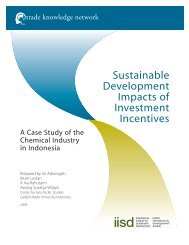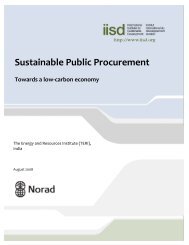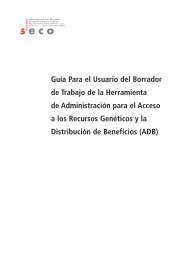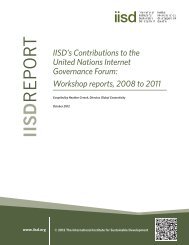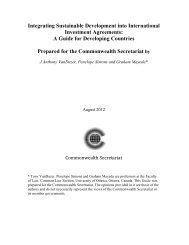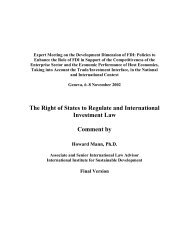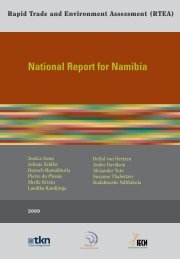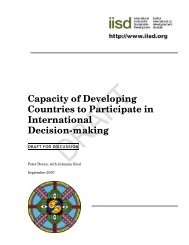2006/2007 Annual Report - International Institute for Sustainable ...
2006/2007 Annual Report - International Institute for Sustainable ...
2006/2007 Annual Report - International Institute for Sustainable ...
You also want an ePaper? Increase the reach of your titles
YUMPU automatically turns print PDFs into web optimized ePapers that Google loves.
Perhaps no other economy in human history has grown as quickly as China’s has<br />
in recent years. But with growth, comes challenge. What does China’s expanding<br />
economy mean <strong>for</strong> sustainable development, and what can be done?<br />
By Wanhua Yang<br />
[IISDFEATURE]<br />
10<br />
China is by far the fastest growing economy in the world; perhaps the fastest in human history.<br />
China’s gross domestic product (GDP) was up 11.1 per cent in the first quarter of <strong>2007</strong>—<br />
0.7 per cent higher than <strong>for</strong> all of <strong>2006</strong>. 1 Growth and rapid urbanization will continue until at<br />
least 2020, when China expects to quadruple its GDP over the year 2000.<br />
China’s environmental problems are also among the most serious in the world. Ninety per cent<br />
of urban groundwater supplies and 70 per cent of rivers and lakes are contaminated; 16 of<br />
20 of the most polluted cities in the world are in China; about 200 Chinese cities fall short of<br />
World Health Organization standards <strong>for</strong> airborne particulates; and more than 30 per cent of<br />
China’s cropland is suffering from acidification. 2 Sulphur dioxide (SO2) emissions alone are<br />
causing an annual 12 per cent loss in gross national product, an amount about equal to the<br />
country’s phenomenal annual growth. 3<br />
Rapid growth has created complex ecological ties with the rest of the world. Some<br />
environmental problems, started in China, already extend beyond the country’s borders.<br />
SUSTAINABLE CHINA?<br />
Meeting the challenges of rapid growth<br />
Airborne pollution and dust from Chinese industry, <strong>for</strong> example, carry to nearby countries<br />
such as Korea and Japan. China provides the headwaters <strong>for</strong> several international rivers<br />
including the Yangtze, Yellow, Mekong and Brahmaputra. Some of these rivers are being<br />
dammed and diverted. And climate change is threatening the glaciers that feed these rivers.<br />
China acts as the world’s largest workshop, producing 30 per cent of the world’s televisions;<br />
30 per cent of the world’s furniture; 50 per cent of the world’s cameras; and 70 per cent of the<br />
world’s photocopiers. 4 While providing cheap goods to many parts of the world, China absorbs<br />
the pollution and bears the related health costs. China’s quest <strong>for</strong> natural resources through<br />
global investment and acquisition has led to surging commodity prices, as well as international<br />
concerns about China’s voracious appetite <strong>for</strong> natural resources and its growing impacts on the<br />
global environment. At the same time, China has become the largest dumping ground <strong>for</strong> the<br />
world’s garbage, including paper and electronic waste.<br />
Currently, China is the world’s second biggest emitter of greenhouse gases after only the United<br />
States. The <strong>International</strong> Energy Agency recently said that China could overtake the U.S. as the<br />
world’s largest emitter as soon as late <strong>2007</strong>, and certainly by 2008. 5 Meanwhile, China will be hit<br />
especially hard by climate change, with longer droughts in the north leading to falling farm<br />
production; heavier rainfall in the south, leading to more flooding and heavy economic losses;<br />
and rising sea levels in China’s wealthy coastal cities in the east.<br />
A polluted river at Humen town, South China: China acts as<br />
the world’s “largest workshop,” writes Wanhua Yang.<br />
iStockphoto<br />
“Growth and rapid urbanization<br />
will continue until at least 2020,<br />
when China expects to quadruple<br />
its GDP over the year 2000.”




